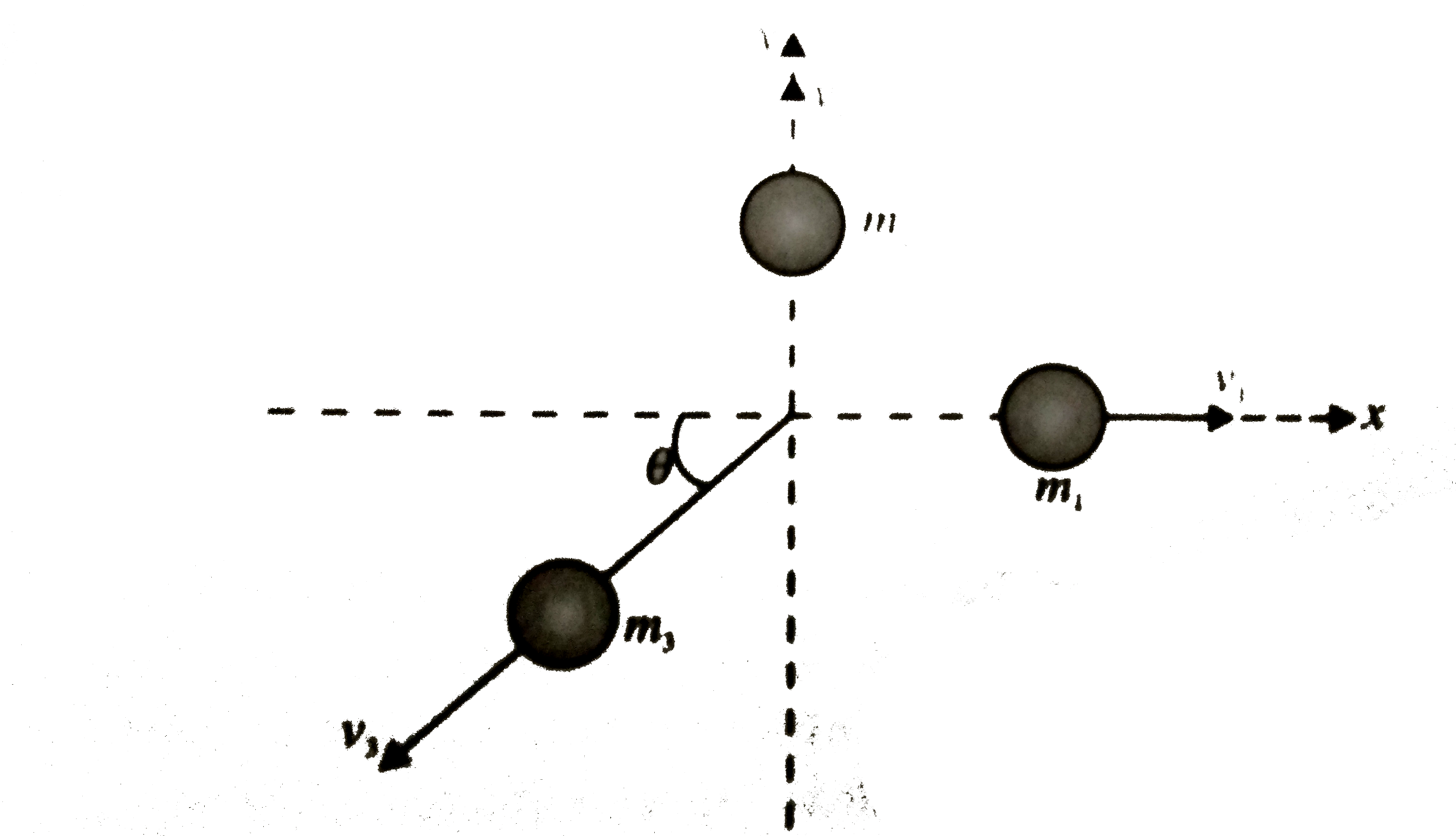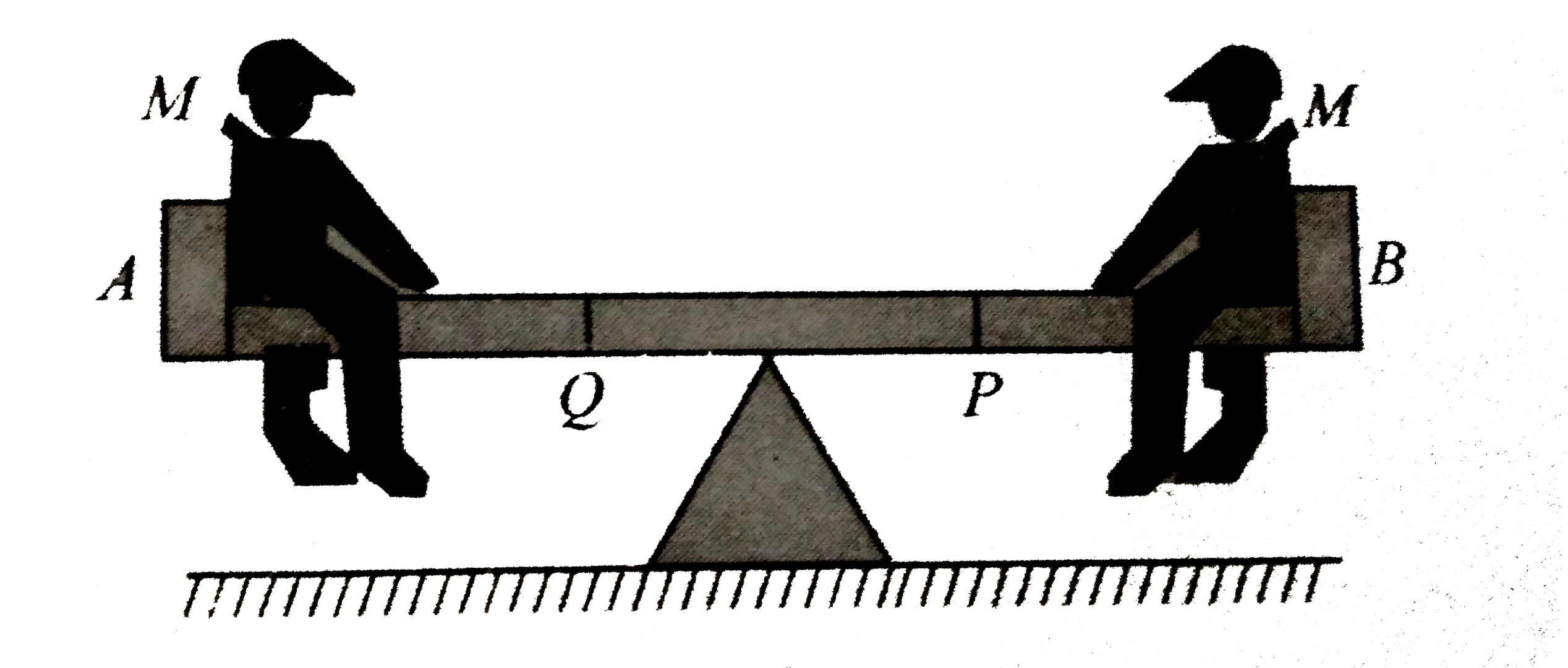An explosion blows a rock into three parts. Two pieces go off at right angles to each other, piece with velocity of and other , piece with a velocity of and other piece with a velocity of . If the third piece flies off with a velocity of compute the mass of the third piece.
Let and be the masses of the three pieces.
Let . Let and be directed along - and -axis respectively, and be directed as shown.

By the principle of coservation of momentum, initial momentum is zero. Hence,
along -axis,
along -axis
and
By squaring and adding we get
Topper's Solved these Questions
- CENTRE OF MASSBook:CENGAGE PHYSICSChapter:CENTRE OF MASSExercise:Solved Examples
Explore 13 Videos
- CENTRE OF MASSBook:CENGAGE PHYSICSChapter:CENTRE OF MASSExercise:Exercise 1.1
Explore 20 Videos
- CALORIMETRYBook:CENGAGE PHYSICSChapter:CALORIMETRYExercise:Solved Example
Explore 13 Videos
- DIMENSIONS & MEASUREMENTBook:CENGAGE PHYSICSChapter:DIMENSIONS & MEASUREMENTExercise:Integer
Explore 2 Videos
Similar Questions
A body of mass 1kg initially at rest, explodes and breaks into three fragments of masses in the ratio 1:1:3. The two pieces of equal mass fly off perpendicular to each other with a speed of 15ms−1 each. What is the velocity of the heavier fragment?
View SolutionTwo children A and B of same mass (including their caps) M are sitting On a see-saw as shown in Fig. Initially, the beam is horizontal. At once, child B throws away his cap (mass M25) which falls at point Q, midpoint of the left half of the beam, due to this the balance of beam is disturbed. To balance it again what is the mass in required to be put at point P on the right half of the beam?

View SolutionA colorimeter contains 400g of water at a temperature of 5∘C. Then, 200g of water at a temperature of +10∘C and 400g of ice at a temperature of −60∘C are added. What is the final temperature of the contents of calorimeter?
Specific heat capacity of water −1000 cal/kg/K
Specific latent heat of fusion of ice =80×1000 cal/kg
Relative specific heat of ice =0.5
View SolutionTo find the distance d over which a signal can be seen clearly in foggy conditions, a railways-engineer uses dimensions and assumes that the distance depends on the mass density ρ of the fog, intensity (power/area) S of the light from the signal and its frequency f. the engineer finds that d is proportional to S1/n. the value of n is
View SolutionA stationary body of mass 3kg explodes into three equal pieces. Two of the pieces fly off at right angles to each other. One with a velocity of 2ˆim/s and the other withl velocity of 3ˆim/s. If the explosion takes place in 10−5 the average force acting on the third piece in newtons
View SolutionAn explosion blows a rock into three pieces Two pieces whose masses are 200 kg and 100 kg go off at 90∘ to eachother with a velocity of 8m/s and 12m/s respectively If the third piece flies off with a velocity of25m/s then calculate the mass of this piece and indicate the direction of flight of this piece in a diagram.

View SolutionA stationary body of mass 3 kg explodes into three equal pieces. Two of the pieces fly off at right angles to each other, one with a velocity 2hati m/s and the other with a velocity 3hatj m/s. If the explosion takes place in 10^(-5) s, the average force acting on the third piece in newton is
View Solutionद्रव्यमान 40 किग्रा का एक विस्फोटक वेग 20 मी/से से चलते हुए दो टुकड़ों में टूट जाता है | यदि एक टुकड़े का वेग शून्य हो तथा दूसरे टुकड़े का वेग उसी दिशा में 80 मी/से हो, तो टुकड़ों के द्रव्यमान ज्ञात कीजिए |
View Solutionविस्फोट के कारण एक चट्टान 1.0 किग्रा, 2.0 किग्रा तथा 2.5 किग्रा द्रव्यमान के तीन टुकड़ों में विभक्त हो जाती है | यदि प्रथम दो टुकड़े क्रमश : 12 मी/से तथा 8 मी/से के वेग से पूर्व तथा दक्षिण दिशाओं में जाते हैं, तो तीसरे टुकड़े का वेग क्या होगा ?
View Solution50 किग्रा द्रव्यमान का एक विस्फोटक 30 मी/से से चलते हुए दो टुकड़ों में टूट जाता है । यदि एक टुकड़े का वेग शून्य तथा दूसरे टुकड़े का उसी दिशा में वेग 60 मी/से हो तो टुकड़ों के द्रव्यमान ज्ञात कीजिए ।
View SolutionAn explosion blows a rock into three parts. Two pieces go off at right angles to each other. 1.00 kg piece with a velocity 12m/sec and the other 2.00 kg piece with a velocity 8m/sec. If the third piece flies off with a velocity 40m/sec, then the mass of the third piece is -
View SolutionAn explosion blows a rock into three pieces. Two pieces go off at right angles to each other. One of these two pieces of mass 1 kg moves with 12 m//s and other of mass 2 kg moves with 8 m/s. If the velocity of the third piece is 40 m//s, then its mass is:
View SolutionA stationary body of mass 3 kg explodes into three equal pieces. Two of the pieces fly off at right angles to each other, one with a velocity 2hati m/s and the other with a velocity 3hatj m/s. If the explosion takes place in 10^(-5) s, the average force acting on the third piece in newton is
View SolutionA stationary body of mass 3 kg explodes into three equal pieces. Two of the pieces fly off in two mutually perpendicular directions, one with a velocity of 3ˆi m s−1. And the other with a velocity of 4ˆj m s−1. If the explosion occurs in 10−4 s, the average force acting on the third piece in newton is
View Solution40 किग्रा का एक विस्फोटक 12 मी/से के वेग से जा रहा है। टक्कर के पश्चात् वह 28 किग्रा व 12 किग्रा के दो टुकड़ों में विभाजित हो जाता है। यदि टक्कर के पश्चात् बड़े टुकड़े का वेग शून्य हो जाए तो छोटे टुकड़े का वेग होगा।
View Solution
